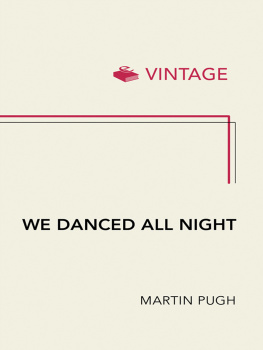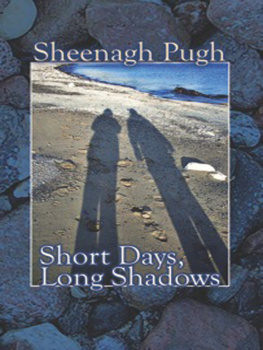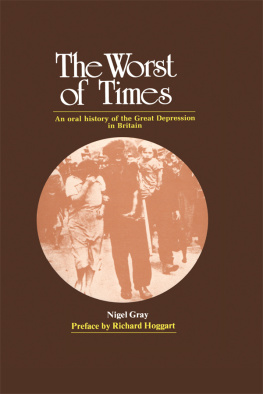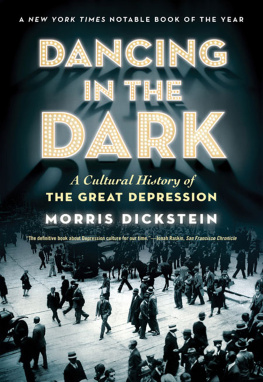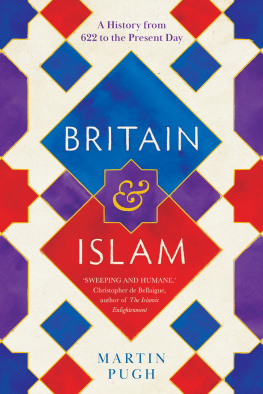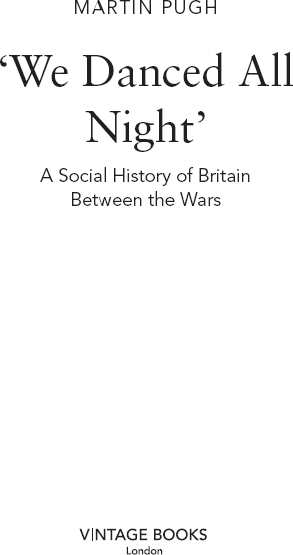Contents
About the Book
Bounded by the Great War on one side and by the looming shadow of the Second World War on the other, the inter-war period has characteristically been portrayed as a time of unremitting poverty, rising crime and mass unemployment. In Martin Pughs lively and thought-provoking new book, however, the acclaimed historian vividly shows how the British people reacted to the privations of wartime by indulging in leisure and entertainment activities of all kinds from dancing and cinema going to smoking, football pools and paid holidays.
He explodes the myths of a nation of unwed women, revealing that in the 1930s the institution of marriage was reaching its heyday, and points to a rise in real incomes, improvements in diet and health and the spread of cheap luxuries. The result is an extraordinary, engaging work of history that presents us with a fresh perspective and brings out both the strangeness and the familiarity of this point in time.
About the Author
Martin Pugh taught history at the Aligarh Muslim University, India, from 1969 to 1971 while working for the Voluntary Service Overseas. He was Professor of British History at Newcastle University until 1999 and Research Professor in History at Liverpool John Moores University from 1999 to 2002. He is a Fellow of the Royal Historical Society, a member of the advisory panel of the BBC History Magazine, and the author of eleven books on nineteenth- and twentieth-century history. He lives in Northumberland where he divides his time between gardening, research and writing.
The great success of Martin Pughs sparkling new volume is to set the familiar events of the 1920s and 1930s in their proper context and to connect them to longer-term patterns of change... this is social history with a human face... this is one those rare books that deserves a wide audience, but which will also be required reading for specialists
BBC History Magazine
An extraordinary book [that] reveals how modern society was born between the wars... comprehensive, often astonishing
Daily Express
It succeeds in bringing out both the strangeness and the familiarity of this odd period of history... allows us to see a version of ourselves in the culture of the Twenties and Thirties in a way we simply cannot when we look at the elusive Edwardians
Daily Telegraph
A lively, tactile history of inter-war Britain
Sunday Times
A fascinating, detailed look at how we lived during the inter-war years
Daily Mail
Preface and Acknowledgements
Demarcated by the tragedy of the Great War on one side and the looming threat of the Second World War on the other, the 1920s and 1930s boast a coherent identity enjoyed by few twenty-year periods of history. It has been seen in fairly stark terms. Interwar social history has often been portrayed in a light-hearted way as the Roaring Twenties, and not entirely wrongly, for, after the privations of wartime many British people were keen to seize any opportunities for leisure and self-indulgence. But at the other end of the spectrum the political history of the period, heavily coloured by economics, presents a gloomy picture of a society dogged by mass unemployment and class divisions, punctuated by protests such as the General Strike and the hunger marches, and dominated by uncaring right-wing governments. The British Left, out of power for most of the period, scored a belated victory in writing the history of the interwar period as one of poverty, failure and reaction. In effect our impressions have been heavily influenced by some celebrated pieces of contemporary literature ranging from novels to autobiographies to ostensibly factual accounts including Walter Greenwoods Love on the Dole (1933), Vera Brittains Testament of Youth (1933), George Orwells The Road to Wigan Pier (1937), and Ellen Wilkinsons The Town That Was Murdered (1939). However, the combination of political bias and the literary skills of their authors make them dubious sources for social historians. Orwells famous Left Book Club volume is more a piece of journalistic embellishment than the kind of sober account he was originally commissioned to write. Brittains moving story is not entirely consistent with the diary she wrote at the time. Moreover, her personal account of the Lost Generation of the Great War has created pitfalls for later students. Quite recently, indeed, it has helped generate Virginia Nicholsons Singled Out: How Two Million Women Survived without Men after the First World War (2007), a notable example of a book based on a myth: that a generation of women was condemned to spinsterhood by the casualties of the war. In fact, as the current volume shows, interwar British women by no means lacked husbands; despite contemporary fears, more of them got married than had before 1914, and by the 1930s the institution of marriage was reaching its heyday in this country.
The present volume reflects the drastic revisionism achieved by modern research on the 1920s and 1930s. The British economy was never as badly affected by the depression as those of the United States or Germany, unemployment was never as high, and the loss of output much less. Nor was depression a continuous feature of the period there were growth phases in 191920, 19228 and 19347. More importantly for our social history, we now recognise that in Britain, as all over the world, this was a bad time for producers in industry and agriculture but a good one for consumers because of the steady fall in prices. As most people managed to retain their employment, the rising real value of their wages made possible the boom in housing, consumption of minor luxuries, motoring, holidays and leisure activities that became characteristic of the era. Indeed, the society of obsessive consumers and shoppers that the British have now become owes its origins to the interwar period. Admittedly the process was interrupted by the Second World War and consequent austerity but it soon reasserted itself. Above all, the dedication to housing in general and to home-ownership in particular that came to dominate British politics and the economy by the later twentieth century finds its proximate origins between the wars. Despite this, no one would attempt to depict the period as an age of improvement as is routinely done for the mid-Victorian era when poverty was far grimmer and more widespread. The explanation is that contemporary Victorians, or some of them, devoutly believed that theirs was an era of progress, and their optimism was not seriously deflated until later in the century and in the First World War. By contrast, the expectations of improvement raised by reform during the Edwardian period were dashed after 1914, leading to a prolonged mood of disillusionment and an underlying fear of national decline.
In writing the current volume I have tried to aim somewhere between two admirable earlier works. As long ago as 1940 Robert Graves and Alan Hodge published The Long Week-End, an exuberant, entertaining and impressionistic account whose chaotic nature was accentuated by the absence of an index and of any organising theme. The book is still well worth reading although they were too close to events to have much perspective on the period. At the other end of the spectrum John Stevensons 1984 volume in the Pelican British Social History, British Society 191445, is scholarly, judicious and well-organised and has been deservedly widely used.
But in addition to differences in tone and structure the present volume differs in several respects from earlier works, even those published in the 1980s. With a frankness one could not get away with today, Graves and Hodge admitted that events in London and its environs are here treated in disproportion to events elsewhere. But this could not be helped. Today we recognise that Britain is not quite the homogeneous little country that the metropolitan Establishment has traditionally assumed her to be. England is once again a country of
Next page
